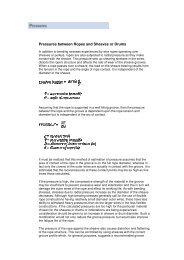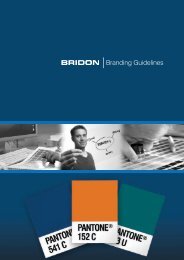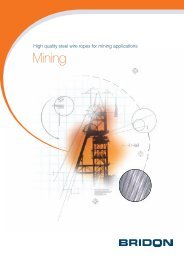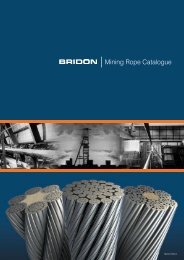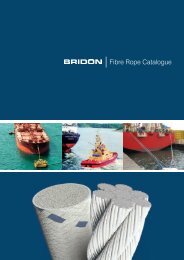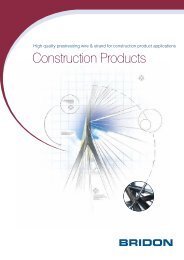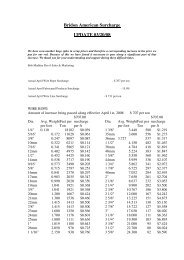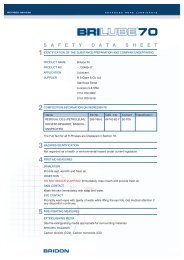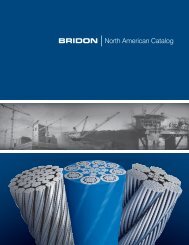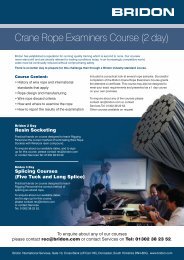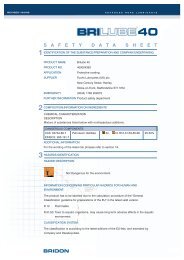Download the full Mining Brochure (Imperial) - Bridon
Download the full Mining Brochure (Imperial) - Bridon
Download the full Mining Brochure (Imperial) - Bridon
- No tags were found...
Create successful ePaper yourself
Turn your PDF publications into a flip-book with our unique Google optimized e-Paper software.
Technical InformationProduct Safety: Instructions & Warnings on <strong>the</strong> use of steel wire ropeWARNINGAny looseness or uneven winding will result inexcessive wear, crushing and distortion of <strong>the</strong> rope.With plain barrel drums it is difficult to achievesatisfactory multi-layer coiling beyond three layers.The direction of coiling of <strong>the</strong> rope on <strong>the</strong> drum isimportant, particularly when using plain barrel drums,and should be related to <strong>the</strong> direction of lay of <strong>the</strong>rope in order to induce close coiling.(See Fig. 12 for proper method of locating ropeanchorage point on a plain drum.)Proper method of locating rope anchorage pointon a plain drumSTART ROPEAT LEFTFLANGERIGHTHANDLEFTHANDLEFTHANDRIGHT HANDLAY ROPE-UNDERWINDRIGHT HANDLAY ROPE-OVERWINDLEFT HANDLAY ROPE-UNDERWINDLEFT HANDLAY ROPE-OVERWINDnote: Thumb indicates side of rope anchorageFig 12When multi layer coiling has to be used it should berealised that after <strong>the</strong> first layer is wound on a drum,<strong>the</strong> rope has to cross <strong>the</strong> underlying rope in order toadvance across <strong>the</strong> drum in <strong>the</strong> second layer. Thepoints at which <strong>the</strong> turns in <strong>the</strong> upper layer crossthose of <strong>the</strong> lower layer are known as <strong>the</strong> cross-overpoints and <strong>the</strong> rope in <strong>the</strong>se areas is susceptible toincreased abrasion and crushing. Care should betaken when installing a rope on a drum and whenoperating a machine to ensure that <strong>the</strong> rope is coiledand layered correctly.3.15 Check <strong>the</strong> state of re-usable rope end terminationsfor size, strength, defects and cleanliness before use.Non-destructive testing may be required dependingon <strong>the</strong> material and circumstances of use. Ensure that<strong>the</strong> termination is fitted in accordance with <strong>the</strong> OEM’sinstruction manual or manufacturer’s instructions.When re-using a socket and depending on its typeand dimensions, <strong>the</strong> existing cone should be pressedout. O<strong>the</strong>rwise, heat may be necessary.WARNINGWhen melting out sockets which have previouslybeen filled with hot metal, <strong>the</strong> emission of toxicfumes is likely. Note that white metal contains ahigh proportion of lead.Correctly locate and secure any connection pins andfittings when assembling end terminations to fixtures.Refer to manufacturer’s instructions.WARNINGFailure to pay attention to any of <strong>the</strong> above couldresult in unsafe operation andpotential injury.3.16 Limit switches, if fitted, must be checked andre-adjusted, if necessary, after <strong>the</strong> rope hasbeen installed.3.17 Record <strong>the</strong> following details on <strong>the</strong> Certificate afterinstallation has been completed: type of equipment,location, plant reference number, duty and date ofinstallation and any re-rating information/signature ofcompetent person. Then safely file <strong>the</strong> Certificate.3.18 ‘Run in’ <strong>the</strong> new rope by operating <strong>the</strong> equipmentslowly, preferably with a low load, for several cycles.This permits <strong>the</strong> new rope to adjust itself gradually toworking conditions.Note: Unless o<strong>the</strong>rwise required by a certifying authority, <strong>the</strong> ropeshould be in this condition before any proof test of <strong>the</strong> equipment ormachinery is carried out.Check that <strong>the</strong> new rope is spooling correctly on <strong>the</strong>drum and that no slack or cross laps develop.If necessary, apply as much tension as possibleto ensure tight and even coiling, especially on <strong>the</strong>first layer.Where multi-layer coiling is unavoidable,succeeding layers should coil evenly on <strong>the</strong>preceding layers of rope.48 BRIDON <strong>Mining</strong>



